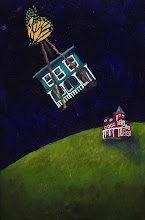

While Olivia and James were visiting Seattle, they visited the Seward Park chapter of the Audubon Society for some birdwatching with bird expert Woody Wheeler and to hear an update on the Gulf spill. I asked James for a recap.
Olivia and I travelled to Seattle last week for the TEDxRedmond convention. While is Seattle, Olivia did a presentation at the Seattle based Seward Park Audubon Center. Dr. Tom Bancroft, a scientist with Audubon, called in from Washington for a question and answer session after Olivia’s presentation.
Dr. Bancroft stated that the Gulf Oil Spill, as feared, has devastated the wildlife in the Gulf of Mexico. He stated that, in a conservative estimate, 8,000 birds have died. This number would not also count the eggs that did not hatch, or many deep water birds that are too far off land to be counted. He ventured that the real number would be more than triple this estimate.
Scientists are finding oil inside the bodies of shrimp that are captured, as well as oil inside the eggs of crabs. The dispersants used by BP have done more harm than good. The effect of the dispersant was to do two things: dissolved part of the oil into a small molecules that are dissolved into the Gulf water and the other effect was to coagulate the oil into a rock like clump, where it sinks to the bottom of the gulf to forever be a part of the eco-system and ingested by bottom feeding aquatic life.
The oil is continuing to wash ashore. There are cleanup crews that gather the oil when they find it.. but it is difficult to gather it all, since it is coming in at so many different locations. If the oil is not discovered quickly, it is covered by sand due to the wave action of the gulf. If covered, he has seen the oil bubble up in different areas, in some cases staying on the beach and in other cases being washed back out into the gulf.
The marshes were already in peril, due to the trenching that the oil companies do to bring the pipelines from the oil rigs in the gulf. They trench right through miles of marsh to get to land. Louisiana loses a football field size of marsh land each day, due to the trenching and the fact that Mississippi River has been diverted and does not deposit the sediment that nourishes the marsh to keep it healthy.
The only silver lining in the oil spill is that Dr. Bancroft is seeing some cooperation between the local and national governments on the spill clean-up and marsh land restoration. He estimated that, while we do not know for sure, it will be decades before the gulf recovers, and even at that time, there will be buried oil deposits that will continue to infiltrate the Gulf eco-system.
While is Seattle, I was able to read the latest National Geographic Magazine, October Issue, 2010. It is one of the best accounts on the oil spill: both in how it happened and what has been the result on the eco-system. I highly encourage people to read the article. In my opinion, the real work in the Gulf is just beginning. Olivia listened to Dr. Bancroft’s presentation. I will admit that it was difficult for her to hear all of the facts. She told me after her talk that she is ready to continue her work to save the Gulf and the many birds that are affected.
Yesterday in my emails I received another update from the National Wildlife Federation, another organization Olivia's fundraiser supported. They report 2,500 brown pelicans have perished, perhaps placing them once again on endangered lists. The work cleaning up the Gulf is far from over and although hearing such news about the wildlife is devastating, it pushes us here to continue fighting until that habitat is restored. It's going to be a long fight.





No comments:
Post a Comment